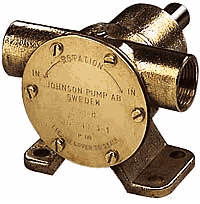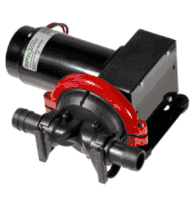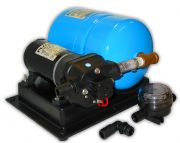| 
|
Engine Cooling Pump
Direct
Cooling
It should be noted that engine manufacturers pay special
attention to the design of engines for direct cooling in order to minimise
corrosion in the cooling passages. However many small craft owners marinise
standard car engines successfully. Raw water (river or seawater) is pumped
directly through the cylinder block, exhaust manifold, exhaust silencer (if
fitted) and exhaust pipe. To ensure efficient engine performance it is essential
that an optimum operating temperature is being maintained by regulating the
amount of cooling water through the cylinder block, either using 'Manual' or
Automatic temperature control.
Heat Exchanger
Cooling
A pump recirculates Fresh Water on a closed circuit through the
cylinder block, thermostat and around the tubes of a heat exchanger (Primary
Cooling Circuit) which is often an integral part of the vented expansion - or
header tank. Cold Raw Water is pumped by a second pump through the heat
exchanger tubes (Secondary Cooling Circuit) and maintains the fresh water in the
primary circuit at an average temperature of 80-90oC.
Keel Cooling
Keel Cooling is basically the same as heat exchanger cooling, except
that the fresh water is recirculated through the keel cooling pipes which are
fitted outside to the bottom of the boat. The heat generated by the engine is
dissipated directly to the raw water flowing around the pipes.
Raw Water
Cooling
Raw water cooling systems demand a great deal from circulating pumps.
They must have the unfailing ability to self prime at various engine speeds and
must be able to pass such solids as sand and silt without impairing the pump's
flow.
On average, petrol engines and fast running diesel engines require a raw water
pump flow of approximately 8-8½gpm (36-39l) for each 100BHP for Direct Cooling
systems and 14½-15½gpm (65-70l) for each 100BHP for Heat Exchanger Cooling
systems.
|
 |  |  |  | Johnson Engine Cooling, Raw Water Handling Pump, F5B-9, 1 1/4" NPT, 10242281

Brand New with Factory Warranty  |  | Johnson Engine Cooling, Raw Water Handling Pump, F7B-8007, 1" NPT, 5/8" Shaft, 10-24572-51

Brand New with Factory Warranty  |  |  |  |  |  | Johnson Engine Cooling, Raw Water Handling Pump, F35B-8, 3/8" NPT, 102456909

Brand New with Factory Warranty  |  | Jabsco Mercruiser-Type Engine Cooling Pump 43210-0001

Brand New with Factory Warranty  |  |  |  |  |  | Jabsco Engine Cooling Pump 50410-1201

Brand New with Factory Warranty  |  | Jabsco Engine Cooling Pump Crusader 42730-0000

Brand New with Factory Warranty  |  |  |  |  |  | Jabsco Pulley Driven Engine Cooling Pump, 8.9 GPM, 1/2" NPT, 1500 RPM with Neoprene Impeller, 1673-1001

Brand New with Factory Warranty  |  | Jabsco Pulley Driven Engine Cooling Pump with Neoprene Impeller, 26 GPM, 1" NPT, 1750 RPM, 7779-001

Brand New with Factory Warranty  |  |  |  |  |  | Jabsco Pulley Driven Engine Cooling Pump with Nitrile Impeller, 26 GPM, 1" NPT, 1750 RPM, 7779-003

Brand New with Factory Warranty  |  | Sherwood Cooling Pump, G21, Pleasurecraft -Ford

Brand New with Factory Warranty  |  |  |  |  |  | Albin Group Engine Cooling Pump for Kohler 4-6 Cylinder Diesel - 4-6.5kW Gas - 12.5 kW Gas

Brand New with Factory Warranty  |  | Albin Group Engine Cooling Pump for Kohler

Brand New with Factory Warranty  |  |  |  |  |  | Albin Group Engine Cooling Pump for Kohler - 5-7 Diesel kW

Brand New with Factory Warranty  |  | Albin Group Engine Cooling Pump for Kohler - 5EKD, 4EFKD, 7.5EKD, 6EFKD, 10EKD, & 8EFKD

Brand New with Factory Warranty  |  |  |  | Albin Group Crank Shaft Engine Cooling Pump

Brand New with Factory Warranty  |  |
**The price is subject to change at anytime without any notice. We
are not responsible for any typographical errors. Any products can be
cancelled from sale at any time.
** All Products sold here are Brand New unless specified
Otherwise and come with Full Manufacturer's Warranty
 WARNING:
This product can expose you to chemicals including Di-n-hexyl Phthalate (DnHP)
which is known to the State of California to cause reproductive harm, and
Vinyl Chloride which is known to the State of California to cause cancer. For
more information go to P65Warnings.ca.gov.
__________________________________________________________________________________________ WARNING:
This product can expose you to chemicals including Di-n-hexyl Phthalate (DnHP)
which is known to the State of California to cause reproductive harm, and
Vinyl Chloride which is known to the State of California to cause cancer. For
more information go to P65Warnings.ca.gov.
__________________________________________________________________________________________
__________________________________________________________________________________________
Please contact us via email
ask@wmjmarine.com or Call us at

__________________________________________________________________________________________
|

Customer Rating

Top Rated |
We
offer online shipment tracking

  |
 |

256-bit Encryption Shopping Cart
All personal information
submitted is encrypted and 100% secure |
__________________________________________________________________________________________
__________________________________________________________________________________________
Recommended Site:
WMJ Marine at Facebook |
WMJ Marine at
Linkedin | WMJ Marine at
Twitter |
Marine Electronics Store
Thank you for visiting WMJ marine for your
Boating Equipment and
Marine Electronics |
|
|
|


















































